
Padmasambhava, also known as Guru Rinpoche and the Lotus Born from Oḍḍiyāna, was a semi-legendary tantric Buddhist Vajra master from India who fully revealed the Vajrayana in Tibet, circa 8th – 9th centuries. He is considered an emanation or Nirmāṇakāya of Shakyamuni Buddha as foretold by the Buddha himself. According to early Tibetan sources including the Testament of Ba, he came to Tibet in the 8th century and designed Samye Monastery, the first Buddhist monastery in Tibet during the reign of King Trisong Detsen. He, the king, and Khenpo Shantarakshita are also responsible for creating the Tibetan Canon through translating all of the Buddha's teachings and their commentaries into the Tibetan language.
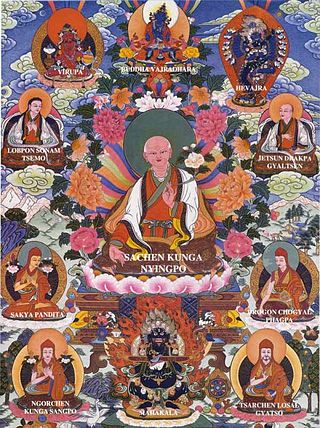
The Sakya school is one of four major schools of Tibetan Buddhism, the others being the Nyingma, Kagyu, and Gelug. It is one of the Red Hat Orders along with the Nyingma and Kagyu.

The Gelug is the newest of the four major schools of Tibetan Buddhism. It was founded by Je Tsongkhapa (1357–1419), a Tibetan philosopher, tantric yogi and lama and further expanded and developed by his disciples.

The Kagyu school, also transliterated as Kagyü, or Kagyud, which translates to "Oral Lineage" or "Whispered Transmission" school, is one of the main schools of Tibetan Buddhism. The Kagyu lineages trace themselves back to the 11th century Indian Mahasiddhas Naropa, Maitripa and the yogini Niguma, via their student Marpa Lotsawa (1012–1097), who brought their teachings to Tibet. Marpa's student Milarepa was also an influential poet and teacher.

Atīśa was a Buddhist religious leader and master. He is generally associated with his body of work authored at Vikramashila Monastery in Bihar, India. He was one of the major figures in the spread of 11th-century Mahayana and Vajrayana Buddhism in Asia, flowing from Tibet to Sumatra. He is recognised as one of the greatest figures of medieval Buddhism. Atiśa's chief disciple, Dromtön, was the founder of the Kadam school, one of the New Translation schools of Tibetan Buddhism, later supplanted by the Gelug tradition in the 14th century which adopted its teachings and absorbed its monasteries.

Mahāmudrā literally means "great seal" or "great imprint" and refers to the fact that "all phenomena inevitably are stamped by the fact of wisdom and emptiness inseparable". Mahāmudrā is a multivalent term of great importance in later Indian Buddhism and Tibetan Buddhism which "also occurs occasionally in Hindu and East Asian Buddhist esotericism."

The Jonang is a school of Indo-Tibetan Buddhism. Its origins in Tibet can be traced to the early 12th century master Yumo Mikyo Dorje. It became widely known through the work of the popular 14th century figure Dolpopa Sherab Gyaltsen. The Jonang school's main practice is the Kālacakra tantra, and they are widely known for their defense of the philosophy known as shentong.

Marpa Lotsāwa, sometimes known fully as Marpa Chökyi Lodrö or commonly as Marpa the Translator, was a Tibetan Buddhist teacher credited with the transmission of many Vajrayana teachings from India, including the teachings and lineages of Mahamudra. Due to this, the Kagyu lineage, which he founded, is often called Marpa Kagyu in his honour.

Nāropā was an Indian Buddhist Mahasiddha. He was the disciple of Tilopa and brother, or some sources say partner and pupil, of Niguma. As an Indian Mahasiddha, Naropa's instructions inform Vajrayana, particularly his six yogas of Naropa relevant to the completion stage of anuttarayogatantra. He was also one of the "gatekeepers" of Vikramashila monastery which is located in Bihar.

Rahul Sankrityayan was an Indian author, essayist, playwright, historian, scholar of Buddhism who wrote in Hindi and Bhojpuri. Known as "father of Hindi travel literature", Sankrityayan played a pivotal role in giving Hindi travelogue a literary form. He was one of the most widely travelled scholars of India, spending forty-five years of his life on travels away from his home in locations like Russia, Tibet, China, Central Asia, etc.

Dzongsar Khyentse Chökyi Lodrö was a Tibetan lama, a master of many lineages, and a teacher of many of the major figures in 20th-century Tibetan Buddhism. Though he died in 1959 in Sikkim, and is not so well known in the West; he was a major proponent of the Rimé movement within Tibetan Buddhism, and had a profound influence on many of the Tibetan lamas teaching today.
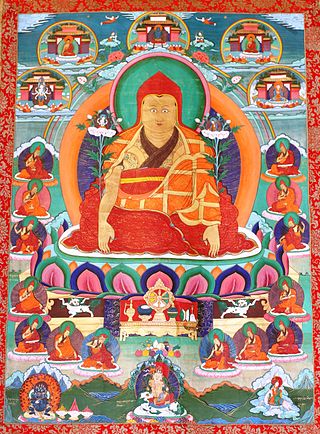
Dölpopa Shérap Gyeltsen (1292–1361), known simply as Dölpopa, was a Tibetan Buddhist master. Known as "The Buddha from Dölpo," a region in modern Nepal, he was the principal exponent of the shentong teachings, and an influential member of the Jonang tradition of Tibetan Buddhism.
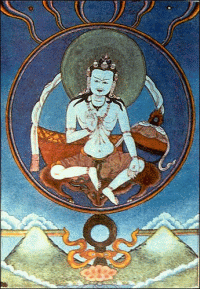
Garab Dorje was the first human to receive the complete direct transmission teachings of Sutra, Tantra and Dzogchen. The circumstances of his birth are shrouded in different interpretations, with some accounts describing a miraculous birth by a virgin daughter of the king of Uddiyana.

Hevajra is one of the main yidams in Tantric, or Vajrayana Buddhism. Hevajra's consort is Nairātmyā.
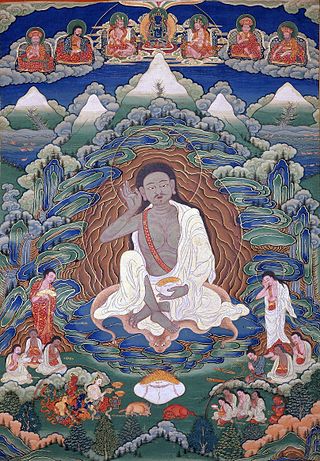
In Tibetan Buddhism and Bon, a ngakpa (male), or a ngakma (female) is any practitioner of Vajrayana who is not a monk or a nun. The terms translates to "man or woman of mantra" or "man or woman of secret mantra". They are often referred to as "householder yogis" or "yoginis" because they maintain a householder lifestyle while engaging in advanced tantric practices.
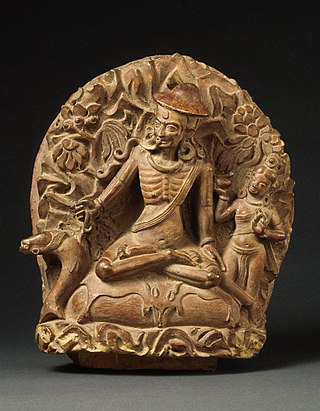
Luipa or Luipada was a mahasiddha siddhacharya from Eastern India. He was a Buddhist saint from the Kãivartā community. He was a poet and writer of a number of Buddhist texts and the Charyapada which is the earliest form of languages like Bengali, Assamese, Odia, Bhojpuri, and Maithili.
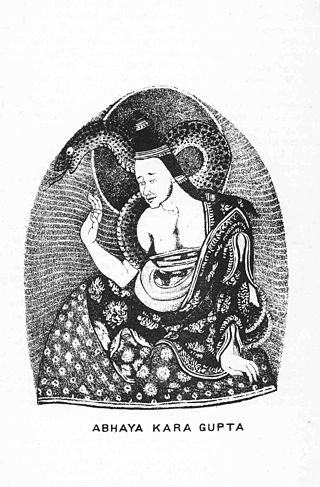
Abhayākaragupta was a Buddhist monk, scholar and tantric master (vajracarya) and the abbot of Vikramasila monastery in modern-day, Bihar in India. He was born in somewhere in Eastern India, and is thought to have flourished in the late 11th-early 12th century CE, and died in 1125 CE.
Lamdré is a meditative system in Tibetan Buddhism rooted in the view that the result of its practice is contained within the path. The name "lamdré" means the “path" with its fruit Wylie: ‘bras). In Tibet, the lamdré teachings are considered the summum bonum of the Sakya school.

Niguma is considered one of the most important and influential yoginis and Vajrayana teachers of the 10th or 11th century in India. She was a dakini, and one of the two female founders of the Shangpa Kagyu school of Vajrayana Buddhism, along with dakini Sukhasiddhi. Her birth name was Shrijnana. Like many of the mahasiddhas and Tantric practitioners of the time, Niguma was known by several names both during her lifetime and afterwards. She was called Yogini Vimalashri, or Vajradhara Niguma, or Jñana (wisdom) Dakini Adorned with Bone (ornaments), or The Sister referring to her purported relationship to the great Buddhist teacher and adept Naropa. She was also sometimes called Nigupta, which is explained by the historical Buddhist scholar Taranatha as follows: "The name Nigu accords with the Indian language, which is Nigupta, and is said to mean 'truly secret' or 'truly hidden.' In fact, it is the code-language of the dakinis of timeless awareness."

Drogmi transmitted the tantric system "Path and Fruit" (Lamdré) which came to be the central esoteric tradition of the Sakya school of Tibetan Buddhism. Drogmi was a famous scholar and translator who had studied at the Vikramashila monastery directly under Naropa, Ratnākaraśānti, Vāgīśvarakīrti and other great panditas from India for twelve years. He is famous for his beard.



















